
Buildings, sites, districts, and objects in Virginia listed on the National Register of Historic Places:

This is a list of structures, sites, districts, and objects on the National Register of Historic Places in North Carolina:

The boundary markers of the original District of Columbia are the 40 milestones that marked the four lines forming the boundaries between the states of Maryland and Virginia and the square of 100 square miles (259 km2) of federal territory that became the District of Columbia in 1801. Working under the supervision of three commissioners that President George Washington had appointed in 1790 in accordance with the federal Residence Act, a surveying team led by Major Andrew Ellicott placed these markers in 1791 and 1792. Among Ellicott's assistants were his brothers Joseph and Benjamin Ellicott, Isaac Roberdeau, George Fenwick, Isaac Briggs and an African American astronomer, Benjamin Banneker.

Walnut Hills United Presbyterian Church is a historic church tower in the Walnut Hills neighborhood of Cincinnati, Ohio, United States. The last remnant of a landmark church building, it was designed by a leading Cincinnati architect and built in the 1880s. Although named a historic site a century after its construction, the building was mostly destroyed after extensive neglect caused restoration to become prohibitively expensive.
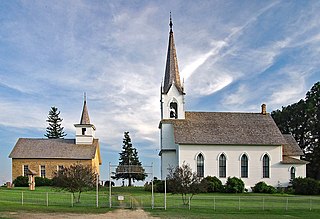
Valley Grove is a historic Lutheran church complex in Wheeling Township, Minnesota, United States. It consists of two 19th-century churches surrounded by a hilltop cemetery. The older building was constructed in stone in 1862 by a rural community of Norwegian immigrants. The congregation outgrew the first church and constructed a larger, wooden replacement in 1894, converting the original building into a guild hall. The property was listed on the National Register of Historic Places in 1982 for its local significance in the themes of architecture, art, and religion. It was nominated for encapsulating two phases of rural ecclesiastical architecture in a dramatic hilltop tableau, and for its role in anchoring eastern Rice County's dispersed community of Norwegian immigrants.
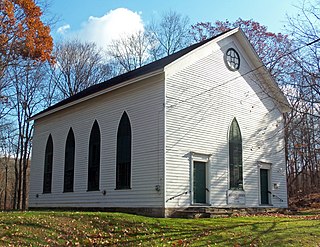
First Presbyterian Church of Wantage is a historic church in Wantage Township, Sussex County, New Jersey, United States. Church records point to a Dutch Reformed congregation founded in 1788, which merged with First Presbyterian Church of Wantage, founded in 1818. The building is situated on a hill, due south of Clove Brook, a creek from which it derives its common name. It was built in 1829 and added to the National Register of Historic Places on September 23, 1982 for its significance in architecture and religion. The structure is no longer used as a church, but the Friends of Old Clove Church continue an inter-denominational service once annually.

The Newtown Presbyterian Church, also known as the Old Presbyterian Church of Newtown, is a historic Presbyterian church complex and national historic district located in Newtown, Bucks County, Pennsylvania.

Pisgah Christian Church is a historic Church of Christ house of worship located outside of Ripley in rural Brown County, Ohio, United States. Constructed in the 1850s for a quarter-century-old congregation, it has been designated a historic site.
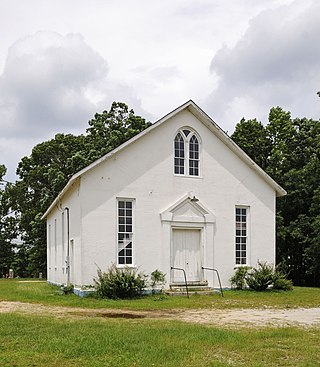
Mount Olivet Presbyterian Church is a historic Presbyterian church located near Winnsboro, Fairfield County, South Carolina. It was built in 1869, and is a one-story, rectangular, front-gabled stuccoed brick building. The stucco is scored to resemble cut stone and the church sits on a granite foundation. The large cemetery northwest of the church contains several historically and artistically significant gravestones dating back to 1795 and is enclosed by a cast-iron fence.

Sardis Baptist Church is a historic church near Union Springs, Alabama.

The Scarborough Historic District is a national historic district located in the suburban community of Scarborough-on-Hudson, in Briarcliff Manor, New York. The 376-acre (152 ha) district was added to the National Register of Historic Places in 1984, and contains seven historically and architecturally significant properties dating from the late 18th century to the early 20th century. Most of the properties are domestic, or used for education or religion. The most common architectural styles within the district are Mid-19th Century Revival and Late Victorian.
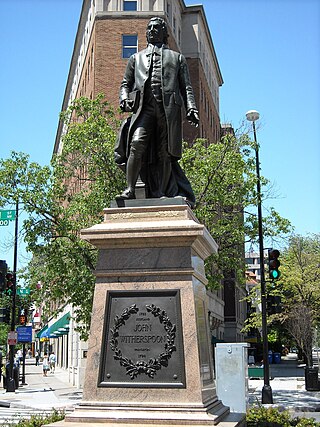
Doctor John Witherspoon is a bronze sculpture and granite pedestal which depicts John Witherspoon, a Presbyterian minister, member of Congress, and signer of the Declaration of Independence. Born in Scotland, Witherspoon immigrated to the U.S. in the 1760s and later became president of the College of New Jersey. He strongly supported the Thirteen Colonies in their fight to obtain freedom from the United Kingdom of Great Britain and Ireland.

The Greensboro History Museum, consisting of the former First Presbyterian Church of Greensboro and Smith Memorial Building, is a historic museum building located at 130 Summit Ave. in Greensboro, Guilford County, North Carolina. The former Presbyterian church was built in 1892 on the site of a former Confederate hospital, and is a Romanesque Revival style brick building with a cross gable roof and tower. The semi-circular, 11 bay, Smith Memorial Building was built in 1903. It features four octagonal sides and a tower. The memorial building was designed by the architect Charles Christian Hook (1870-1938). The church and memorial building were connected and the older structures modified and renovated in 1938. Also located on the property is the First Presbyterian Church cemetery, established in 1831, after the first church was built on land that was donated by Jesse H. Lindsay. The church vacated the property in 1929, and in 1937-1938 it was renovated and enlarged as the Richardson Civic Center and donated to the city of Greensboro. It subsequently housed the Greensboro Public Library, the Greensboro Historical Museum, and the Greensboro Art Center. The historic building functions as one part of the current, larger Greenboro History Museum.
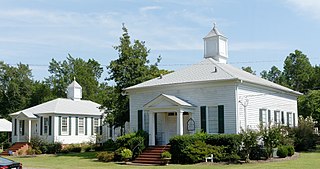
Bath Presbyterian Church and Cemetery is a historic church in Blythe, Georgia.

Lincolnton Presbyterian Church and Cemetery is a historic Presbyterian church and its cemetery on N. Washington Street in Lincolnton, Georgia, in Lincoln County, Georgia. The property was added to the National Register in 1982.

New Dublin Presbyterian Church is a historic Presbyterian church complex located at Dublin, Pulaski County, Virginia. It was built in 1875, and incorporates part of a church built in 1840. It is a one-story, gable-roofed stuccoed brick church building. It primarily exhibits Greek Revival style character, with Gothic Revival style influences. It features a front entry with fanlight, a rose window, two-bay side elevations, a metal sheathed gable roof, and a limestone foundation. Also on the property are a contributing 1874 manse, a cemetery established on the eve of the American Civil War, and an outbuilding.

The McCanaan Missionary Baptist Church is an active church in Sardis, Georgia. It serves members in Burke County, Georgia and Screven County, Georgia. Together with its cemetery, it was listed on the National Register of Historic Places in 2001 as McCanaan Missionary Baptist Church and Cemetery.
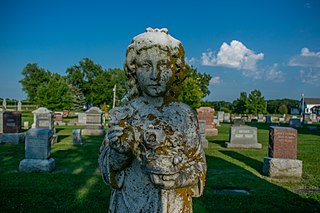
Sharon Cemetery Historic District is located in rural Harrison Township, Lee County, Iowa, United States near the town of Farmington. It was listed on the National Register of Historic Places in 1991. At the time of its nomination the historic district included four contributing buildings, one contributing site, eight contributing structures, and one contributing object.
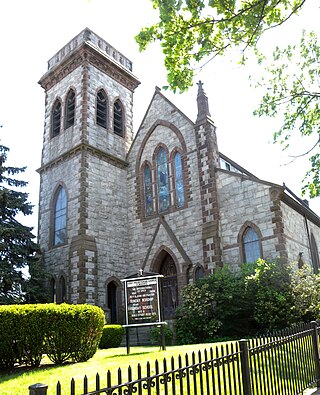
The First Presbyterian Church of Newtown is a historic Presbyterian church in the Elmhurst neighborhood of Queens in New York City. The church complex is composed of the main church, a parish hall, and a manse. The current complex at 54th Avenue, between Seabury Street and Queens Boulevard, is the fifth church complex built for the congregation.

The Old Stone Church is a historic sandstone church located in Kingwood Township in Hunterdon County, New Jersey, United States. It was built in 1837 and is now owned by the First Unitarian Universalist Fellowship of Hunterdon County. The church, described using its historic name, Old Stone Presbyterian Church in Kingwood, was added to the National Register of Historic Places on January 25, 2018 for its significance in architecture. The earlier church located here was a smaller stone building built in 1755, called the Old Stone Meetinghouse. The stones from this church were probably used to build the current one. The Kingwood congregation was established in 1728 and grew during the First Great Awakening, with Gilbert Tennent and George Whitefield preaching here in 1739.






















